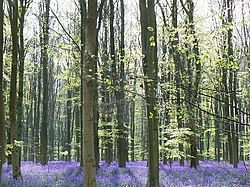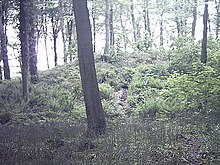West Woods
West Woods is a large wood, located near the market town of Marlborough in the English county of Wiltshire, United Kingdom. Its area is approximately 957 acres (387 ha). It is open to the public, and is popular with visitors in the Spring due to the large number of bluebells which cover the forest floor.
| West Woods | |
|---|---|
 | |
| Geography | |
| Location | Marlborough, Wiltshire, United Kingdom |
| Coordinates | 51°23′47″N 1°46′36″W |
| Area | 957 acres (387 ha) |
Background
West Woods was once part of the Royal Hunting Forest of Savernake until the bounds were changed in the 1330s. Along with Savernake Forest and Collingbourne Woods it now forms part of Marlborough Woodlands. The woods are a very extensive area of beech woodland. [1] West Woods is approximately one fifth of the size of Savernake and was clear felled in 1928, then later replanted. [2] The woods have been visited since before the Bronze Age supplying flints and later charcoal facilities. [3]

Archaeological interest
In July 2020, it was announced that West Woods was the most likely origin of most of the sarsen stones used to create Stonehenge.[4] Archaeologists analysed a core from one of the stones, taken in 1958, and compared it to samples from 20 sarsen outcrops around the country. The whereabouts of the core was unknown until it was returned from the USA by Englishman Robert Phillips in 2019.[5][6]
West Woods also contains a Neolithic long barrow, near the village of Clatford[7][8][9] and is bisected by an ancient earthwork known as the Wansdyke, dating back to the 5th or 6th Century BC.[9]
In February 2007 the Wiltshire Archaeological and Natural History Society conducted the first of a series of surveys which revealed considerable detail about West Wood and the surrounding areas, producing evidence covering a range of different time periods including Mesolithic, Neolithic, post Medieval and undated. This report was published on the official WANHS website within a subheading covering the organisation's reports. The report discusses the findings of four seasons worth of field work and includes detailed maps and tables of discoveries found. Two different versions of the report are available and the second is considerably longer. [10] [11]
Nearby places
References
- Trust, Woodland. "West Woods". Woodland Trust.
- "West Woods". www.wiltshirewalks.co.uk.
- "West Woods". December 16, 2016.
- "Mystery of origin of Stonehenge stones solved". BBC News. 2020-07-29. Retrieved 2020-07-29.
- "Missing part of Stonehenge returned". BBC News. 2019-05-08. Retrieved 2020-07-29.
- Hershberger, Scott (July 29, 2020). "One Mystery of Stonehenge's Origins Has Finally Been Solved". Scientific American. Retrieved 31 July 2020.
Detailed testing of the chemical signature of the Neolithic monument’s most prominent large stones pinpointed where they came from
- "West Woods Long Barrow". The Megalithic Portal.
- Castleden, Rodney (October 24, 2014). "Neolithic Britain: New Stone Age sites of England, Scotland and Wales". Routledge – via Google Books.
- "Area 15: Savernake Forest and West Woods - Historic North Wessex Downs". www.historicnorthwessexdowns.org.uk. Retrieved 2020-07-29.
- "WANHS West Woods Part 1" (PDF). Retrieved 2020-07-30.
- "ADS Archaeology Data Service Amadio, L. (2011). West Woods, Wiltshire: An Archaeological Survey. Devizes: Wiltshire Archaeological & Natural History Society" (PDF). Retrieved 2020-07-30.